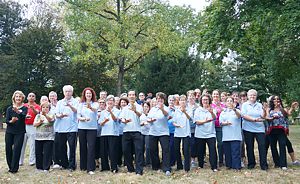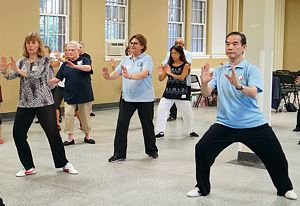How Does Tai Chi Work for Diabetes?
|
By: Dr Paul Lam
� Copyrights Tai Chi Productions 2007. All rights reserved, no part of this article may be reproduced in any forms or by any means, without permission in writing, except for non-profit educational purpose. For example: you can photocopy this article for a friend, paying student, or conference participant as long as this article is not included as part of your charge.
|
| How Does Tai Chi Work For Diabetes?
Many people, however, are unable to keep up with their regular exercise because they either don’t enjoy it, or have a problem finding time to exercise. Tai chi offers a major advantage: It’s enjoyable, and to many, it’s almost addictive. After getting over the initial learning phase (about three to six months) and becoming familiar with the rhythm and feel of tai chi, most people continue exercising. You can practice Tai Chi almost anywhere. Gentle exercise has been shown by studies to prevent diabetes in 60 percent of cases (reference 1, reference 2). Therefore, since tai chi is a gentle exercise, we can assume that it’s effective in preventing and improving the control of diabetes. Stress stands in the way of controlling diabetes. Since tai chi encourages mental relaxation and reduces stress, it follows that Tai Chi can improve the control of diabetes.
The major problems of diabetes are the associating complications such as heart disease, visual impairment, and stroke. Tai chi focuses on building strength, balance and flexibility through slow, fluid movements combined with mental imagery and deep breathing. Scientific studies have shown tai chi to have beneficial effects on cardio-respiratory fitness, muscular strength, balance, peripheral circulation, reduced tension, and anxiety.(reference 3,reference 4, reference 5, reference 6, reference 7, reference 8). These in turn minimise the complications of diabetes.
Diabetes causes peripheral neuropathy, a condition in which the nerves in the feet are damaged thus affecting stability in walking. Tai chi has proved to be effective in helping balance and mobility. The Power of the Mind
Chinese Traditional Medicine and the Power of Qi Qi is the life energy inside a person. The concept of qi is fundamental in most eastern cultures. In fact, Chinese traditional medicine is based on this concept. Designed to cultivate and enhance qi, tai chi encourages gentle and slow movements which strengthen one’s meridians (energy channels along which qi travels) and keeps them strong. The rhythmic movement of the muscle and joints pump energy through the whole body. According to traditional Chinese medicine, diabetes is a deficiency of moisture and essence (yin) of the lung, spleen and kidney meridians . Enhancing qi in the appropriate meridians (reference 9) will therefore improve diabetes. Tai Chi for Diabetes – A specially designed program supported by Diabetes Australia Designed to help prevent and improve control of diabetes by gently increasing physical activities, cellular uptake of glucose and relaxation. It enhances Qi (life energy), which according to traditional Chinese medicine will help control diabetes. This program can be used for general fitness and health. The program includes a general introduction of Tai Chi and diabetes, warm up and cooling down exercises, Qigong for Diabetes, 11 basic movements and 8 advanced movements. Viewers can learn different part at their own pace using the easy-to-learn and step-by-step instructions. You can subscribe the online lessons or purchase your copy of this DVD from our store or your local Diabetes Australia’s branches. Reference for Diabetes |

 Diet and exercise are the cornerstone of diabetes management. People with diabetes who exercise regularly have better control over their blood glucose levels and fewer complications such as heart disease and stroke.
Diet and exercise are the cornerstone of diabetes management. People with diabetes who exercise regularly have better control over their blood glucose levels and fewer complications such as heart disease and stroke. Tai chi enhances concentration, clarity of the mind, improves relaxation and uplifts the mood. The immense power of the mind has not been fully estimated. As one of the most effective mind-body exercises, tai chi helps the student to be aware of the intrinsic energy from which he or she can perceive greater self-control and empowerment.
Tai chi enhances concentration, clarity of the mind, improves relaxation and uplifts the mood. The immense power of the mind has not been fully estimated. As one of the most effective mind-body exercises, tai chi helps the student to be aware of the intrinsic energy from which he or she can perceive greater self-control and empowerment.